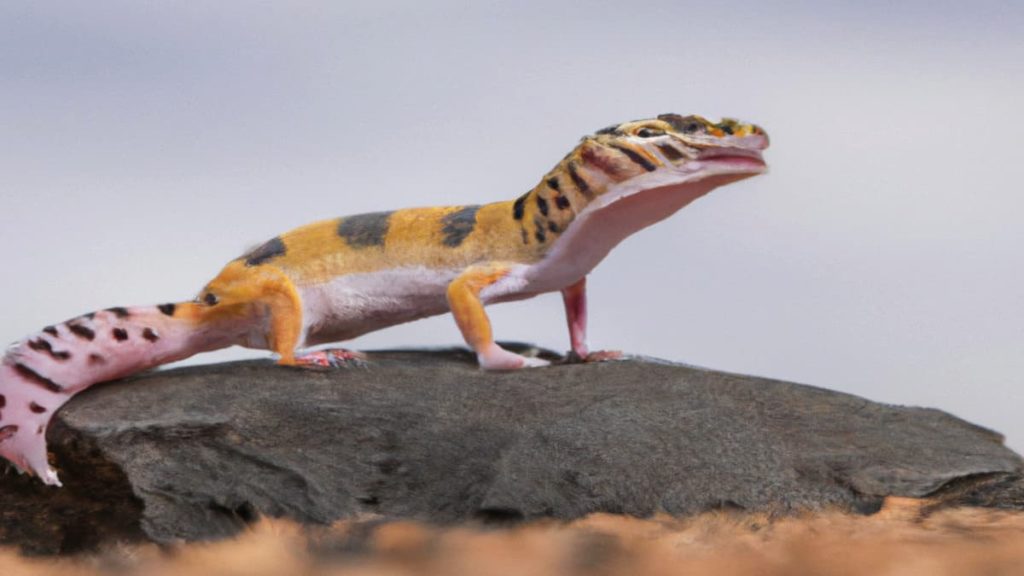
The tails on leopard geckos are one of the most fascinating parts of their bodies. Their tail should normally be fatter than their stomach area. Leopard geckos that have a real thin tail are unhealthy or possibly sick. In this article, I want to discuss everything about leopard geckos tails.

Leopard Gecko Tail Behavior
Like a lot of lizards, leopard geckos can drop their tails. They do this to distract the predator that might be trying to eat them. Their tails keep moving for a short duration of time after it detaches. It is a defensive mechanism that distracts the predator long enough so they can run into a hide.
Geckos do use their tails for communication – so you can sometimes tell how they are feeling by what they do with their tail. So what does it mean when a leopard gecko shakes its tail?
Wagging Tail Slowly
If they are waving or shaking their tail slowly, this is normally a signal to other geckos to say “I’m here, and I know you are there too”. Often they will lower their bodies to the ground when they do the slow tail wave.
Rapid Tail Wagging
The fast tail wave/shake is typically done by a male in the presence of a female. It’s a sign to let the females know that there is a male about, and that he knows the ladies are there.
Defensive Posture & Tail Wagging
As you will probably know, geckos can ‘drop’ their tails if a predator is after them as a diversion tactic (“eat that not me!”). But this is extreme – it takes a lot of effort to regrow a tail, so they don’t want to be doing that often!
So geckos have a defensive response where they will lower their body while keeping their head high to look at the source of the threat. They then point their tail in the air and slowly wag it. This could be in response to a predator, another gecko that they are wary of, or even you if you surprised them or they aren’t used to you yet.
This behaviour applies to males and females so if you see a female leopard gecko wagging her tail at a male, then she is probably not sure of him and being defensive.
If you do see your gecko in this posture, don’t pick them up as you are likely to scare them even more and get bitten. Instead just stay calm, still and quiet until your gecko realises you are not a threat and relaxes.
If you are trying to get your gecko used to you so you can handle them (see taming your leopard gecko), then just take your time. You can build up to slowly moving your hand into the tank – not near your gecko, keep it at a distance – and then hold it still. Your gecko will learn that it is not a threat after all and eventually it will come and investigate instead of behaving defensively and/or running to hide.
Leopard Gecko Tail Loss & Regeneration
Like a lot of lizards, leopard geckos can drop their tails. They do this to distract the predator that might be trying to eat them. Their tails keep moving for a short duration of time after it detaches. It is a defensive mechanism that distracts the predator long enough so they can run into a hide.
Care After Tail Loss
Firstly, relax 🙂
Don’t freak out if your gecko drops their tail – it’s a natural mechanism and won’t harm them long term.
Just remember they are going to be more scared about it than you. So let your gecko chill out quietly in their hide for about 30 minutes to an hour. If you try to pick them up after losing their tail, they will be very panicky. So leave them be for a while to calm down. You might need to calm yourself at the same time as it can be a bit distressing to see.
But don’t worry, just remember, it is a natural defence mechanism.
First Aid Wound Care
- If your leopard gecko has cage mates, remove the one that lost their tail and keep them on their own for a while.
- In their new habitat make sure you just use paper towels or gecko carpet for a substrate.
- With their moist hide make sure you remove their moss. You don’t want that to get in their wound. I would use a paper towel for their moist hide.
- You can use a disinfectant with a cotton bud to treat the geckos wound – just gently dab the area. I found this excellent article on disinfectants for reptiles.
If you notice that your leopard gecko is swelling up, oozing or getting red you might want to consider taking them to the vet right away.
How Long Does A Leopard Gecko Tail Take To Grow Back?
If you feed them properly, it usually takes about 65 days for it to grow back fully. It won’t ever look the same, though. Instead, it will be smoother and have a ‘knob’ shape to it.
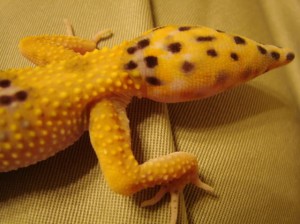
Tail As A Fat Store
Since a good amount of their food reserve is stored in their tail, you are going to want to make sure you give them plenty of food so they can recover quicker. I do recommend getting some wax worms because they help fatten up your leopard gecko. Only give them 2 or 3 wax worms a day because they can get addicted to wax worms. It’s important to feed them extra calcium to make sure they are getting the proper nutrients to recover quickly.
Tail Health and Care
Signs of a Healthy Tail
A healthy leopard gecko tail should be fatter than their stomach area. This indicates that the gecko is well-fed and storing fat properly.
Signs of an Unhealthy Tail
Leopard geckos that have a real thin tail are unhealthy or possibly sick. If you notice that your leopard gecko’s tail is thinning, it may be a sign of illness or malnutrition.
Preventing Tail Loss
Can you stop a gecko losing their tail? It’s common for leopard geckos to drop their tail if they are frightened. Maybe you picked them up by their tail, and you freaked them out. If so, just make sure you handle them more carefully, and don’t pick them up by the tail. Then it shouldn’t happen again.
Sometimes leopard geckos fight (even two females). So it’s important to separate them if they are fighting. Two males should never be housed together. Read more about this in can leopard geckos live together.
Personally, I have never had my leopard geckos lose their tails. But in case it ever happens to you, at least you now know why – and what to do about it.
So if you see your leopard gecko waving their tail at least you now have a better idea of what is going on in their head. Understanding the tail behavior of your leopard gecko can help you better care for your pet and ensure its health and happiness.
Additional Insights into Leopard Gecko Tail Health
While a leopard gecko’s tail is a fascinating subject, there are some additional aspects that you should be aware of to ensure your pet’s well-being.
Tail Coloration and Morphs
Sometimes, you may notice that your leopard gecko’s tail color differs from its body color. This could be a feature of the species or a specific morph. It’s generally not a cause for concern but can be an interesting aspect of your pet’s appearance.
Parasites and Tail Health
If you notice any unusual changes in your gecko’s tail, it could be due to parasites. A fecal test can confirm this, and appropriate treatment can be administered.
Nutritional Considerations
The type of insects you feed your gecko can impact its tail health. Nutrient-rich insects like wax worms or dubias can help improve the tail’s condition. However, moderation is key to prevent obesity.
Weight Distribution
If your gecko is gaining weight but its tail remains skinny, it could be a sign of an underlying issue. Consult a vet for a comprehensive health check.
Your Questions About Leopard Gecko Tails
Why do leopard geckos wag their tails?
Leopard geckos wag their tails as a form of communication. The way they wag their tail can indicate different feelings or intentions, such as excitement, defensiveness, or acknowledgment of another gecko’s presence.
Why is my leopard gecko wagging its tail slowly at me?
If your leopard gecko is wagging its tail slowly at you, it’s likely acknowledging your presence. This is a common behavior when they are aware of another creature’s presence.
What does it mean when a leopard gecko wags its tail?
The meaning of a leopard gecko wagging its tail depends on the context and the manner of the wagging. It can be a sign of excitement, defensiveness, or a way to communicate with other geckos.
Why is my female leopard gecko wagging her tail?
Female leopard geckos may wag their tails for several reasons, such as acknowledging the presence of another gecko, expressing excitement, or displaying a defensive posture.
Do leopard geckos store food in their tail?
Yes, leopard geckos store fat reserves in their tails, which they can use for nourishment when food is scarce.
What does it mean when a leopard gecko raises its tail?
When a leopard gecko raises its tail, it’s usually a defensive posture. They do this to distract potential predators, focusing their attention on the tail rather than the gecko’s body.
Why is my leopard gecko wagging its tail fast?
Fast tail wagging in leopard geckos is typically a sign of excitement or agitation. Male geckos often wag their tails quickly in the presence of a female.
Do leopard geckos tails grow back?
Yes, if a leopard gecko loses its tail, it can regrow a new one. However, the new tail will not look exactly like the original and will have a smoother, knob-like shape.
How big should a leopard gecko tail be?
A healthy leopard gecko’s tail should be fatter than its stomach area. This indicates that the gecko is well-fed and storing fat properly.
Why does my leopard gecko shake his tail when hunting?
Tail shaking during hunting is a sign of excitement in leopard geckos. It’s a common behavior observed just before they attack their prey.

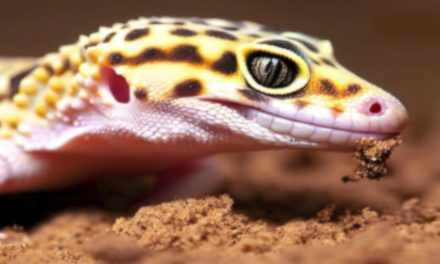
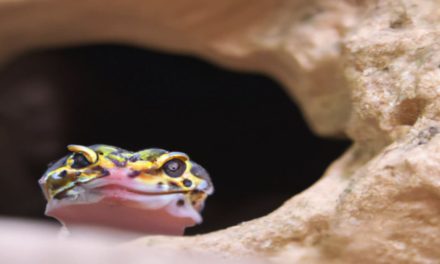
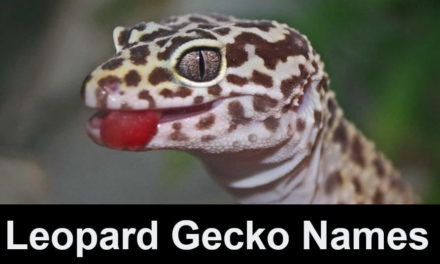
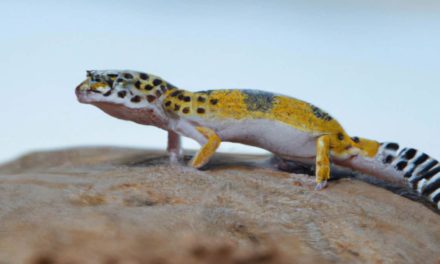










I have a leopard gecko and her tail is really thin – should I take her to the vet or feed her mealworms?
I’ve got a serious concern with my new geckos tail… I need to show someone a picture of it if possible ASAP. Please let me know if you can try to point me into the right direction!
When you have serious worries, it’s always worth going straight to a vet for proper advice. You can contact an online vet here. Hope everything goes well though – and let us know how you get on?
My baby leopard gecko seems fairly healthy, and his tail is nice and fat, but he started to get a pink bump on the end of his tail. I looked it up, but couldn’t find any results. I thought it would go away, but it has grown, and it looks like it is growing to an extension of his tail. There isn’t any skin on it, but it doesn’t seem to be sensitive or painful, but I have never had a gecko before. I have only had him for two weeks, and his tail looked normal, but I wondered if maybe his tail fell off before I got him, and he is just growing it back. Or, I’m just overthinking it and he is just still growing.
Is this normal?
What is happening?
My leopard gecko lost half of its tail – how long will it take to grow back now?!
My leopard gecko still has a smaller tail. I have fed him with crickets who are nutrition filled. He doesn’t seem to have a loss of appetite or any of the other issues listed with skinny tail disease. I’m not sure how to get him to get a fatter tail. Please help? Can I feed him daily?
Try feeding him mealworms to see if he only likes a diet on them instead of feeding it something it doesn’t like.
My leopard gecko has lost his tail what should I do?
Don’t panic, it’s not as bad as it seems :-), and read this bit on care after tail loss.
My leopard gecko hasn’t dropped his tail probably it’s like it’s cut (half hanging off) should I just leave him, will it heal? I have put paper towel down.
My gecko hasn’t eaten in two days but her tail has gotten a lot bigger, is that normal?
Hi,
I have a female leopard gecko around 15 years old. She’s a great size, eats really well, but her tail doesn’t grow fat like I see with most geckos. Instead her tail is long and fairly chubby, about as thick as my thumb. I guess my question is. Is it normal for the tail to grow long and slightly chubby instead of getting super chubby and being short?
A friend of mine has a gecko. It shed its tail a few weeks ago, and she hasn’t been eating! However, her tail seems to be growing back?!
I have a leopard gecko that is 16-18 years old. His tail is skinny. I don’t think he’s storing food in his tail like he used to, however he is still eating. Is a skinny tail common in older leopard gecko’s?
It depends what you mean by skinny. There is a condition called stick tail which is most commonly caused by an intestinal infection, and this can lead to a thin tail. You should really take them to the vet to get properly assessed.
If they ever hatch, do u have to seperste the babies from their parents? How many babies can they have at a time?
I haven’t ever owned a leopard gecko, or indeed a gecko of any kind, but I think they look really pretty and I would do my very best to look after them if I did have any. Articles like this one are very informative and I learned things I never knew before. For those who do own a lizard like this, I am sure that the tips about keeping males apart and females apart is very helpful, and especially this part about the tails, because that must be very alarming for both pet and owner when it happens. It’s good to know it can have a happy ending.
I did have a question about leopard geckos and shaking their tales really slowly. What does this mean?
When they are moving their tail very slowly they are usually just letting you know they are there. I have written an article on their body language.
That is fascinating! I’ve heard of star fish shedding a limb like that but I didn’t know that geckos would do it with their tails.
I appreciate that you’re giving advice about what to do if it happens, even though it’s never happened to you. It shows you’re really passionate about these little guys.
This is my first time reading about a leapord gecko. What an amazing type of lizard! I found it interesting how they drop their tails as a defensive mechanism to distract the predator long enough so they can run into a hide.
I like how you provide a first aid wound care in case anything would happen to it. Thank you for sharing!
Do any of their other body parts grow back?
No none of their other body parts grow back 🙂
Great article about the Leopard Gecko! I didn’t know that you should remove them from sand if they should get a cut or wound. I do now though and I will definitely start using a disinfectant should that ever happen to my Gecko. My Geckos have never lost their tails, but I now know what to do should that ever happen! Thanks for the great article! Martin
Yep, I once had a leopard gecko that was fighting with a cage mate and ended up dropping his tail. Some sand got in his cut and it started to swell up a lot. I had to take him to the vet and we had to give him some medicine. It took him 5-7 days but he recovered and his tail grew back after about 45 days.
I was sad but I am happy he didn’t die. He’s a great little lizard.
Thank you for sharing this information. I think Leopard Geckos are adorable. I use to have salamanders when I lived back east, and found them to be amazing little creatures. Wishing you all the best with your little friends.